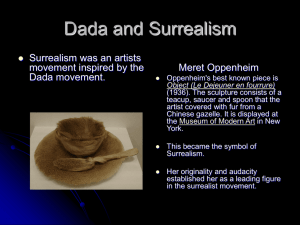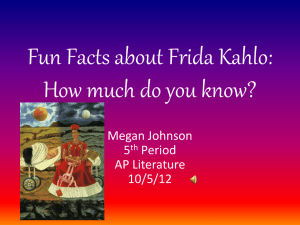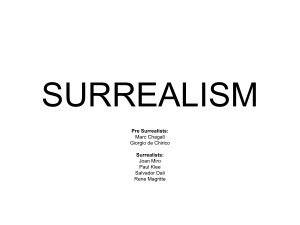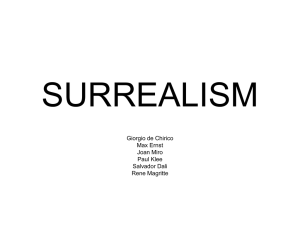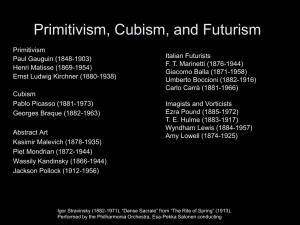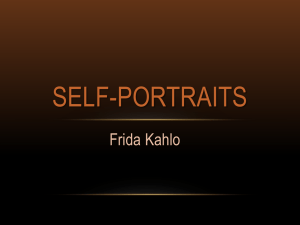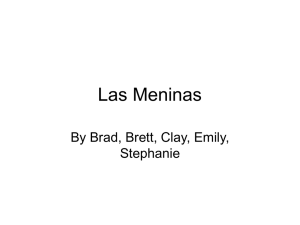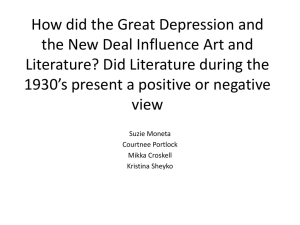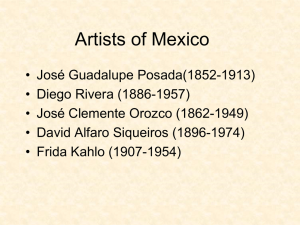ART HISTORY LECT 28 Part II
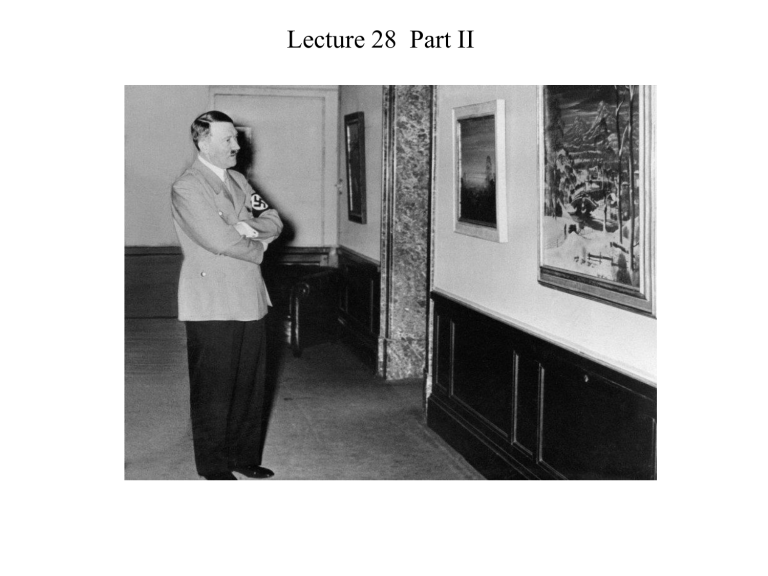
Lecture 28 Part II
Photo taken of the Degenerate Art Show
“From the moment they came to power, the Nazis launched a vicious campaign against art they designated "degenerate," a category that included all modernist art, especially abstract, Cubist, Expressionist, and
Surrealist art. Thus Picasso, Matisse, Klee, Kandinsky, Kirchner, and even nineteenth-century Impressionist and Post-Impressionist artists including
Renoir, Degas, Cézanne and Van Gogh, were reviled as exponents of avant-garde art movements that were considered intellectual, elitist, foreign, and socialist-influenced. Jewish artists such as Marc Chagall were, of course, singled out for special condemnation. The Nazi government promoted a "true" German art, continuing in the tradition of
German nineteenth-century realistic genre painting, that upheld
"respectable" moral values and was easy to understand. Hitler's inner circle also treasured certain Old Masters whom they regarded as expressing the true Aryan spirit, in particular Rembrandt, Cranach, and
Vermeer. Museum directors and curators who refused to cooperate with the new anti-modernist collecting policies were dismissed.
In 1937, in order to purge German museums of their holdings of
"degenerate" art, Joseph Goebbels, Minister for Propaganda and Public
Enlightenment, charged a commission headed by Adolf Ziegler, one of
Hitler's favorite artists (see next slide), with the seizure of works of
German "degenerate" art created since 1910 owned by German state, provincial and municipal museums. Although the primary focus was on
German art, the Ziegler commission's reach soon expanded to encompass non-German artists such as the Dutch abstract painter Piet Mondrian. The confiscated art was gathered in a huge exhibition in Munich to educate the German people about the "evils" of modern art, and especially its alleged Jewish/Bolshevist influences. Marc Chagall's Purim , confiscated from the Museum Folkwang in Essen, was one of the paintings selected for this infamous exhibition, entitled "Degenerate Art" (Entartete Kunst), which opened in Munich on July 19, 1937. Exhibition organizers surrounded the paintings and sculpture with mocking graffiti (previous slide) and quotations from Hitler's speeches, designed to inflame public
Adolf Ziegler Girl with two fruit baskets
1930 (one of Hitler’s favorite artists)
Arno Breker , Readiness , (detail) 1939
Arno Breker, Readiness , 1939
Note: Another favorite of the Nazi Party, Arno Breker’s (above) large sculptures embodied the aggressiveness of the Nazi military. As well as, its idealistic understanding of the pure male German form. You could certainly see the aesthetics of the Nazi’s was a far cry from the general interests of the European avantgarde of the time.
Photo taken of the Degenerate Art Show opinion against this "decadent“ avant-garde art. Ironically, the exhibition attracted five times as many visitors (36,000 on one Sunday alone) as the equally large "Great German Art Exhibition" of Nazi-approved art that opened in Munich at the same time.”
(http://www.philamuseum.org/collections/98-296-110.html)
The, “Degenerate Art exhibition included 650 works of art confiscated from 32 German museums. For the National Socialists, the term
“degenerate” applied to any type of art that was incompatible with their ideology or propaganda. Whole movements were labeled as such, including Expressionism, Impressionism, Dada, New Objectivity,
Surrealism, Cubism, and Fauvism, among others. Many of Germany’s most talented and innovative artists suffered official defamation: for example, George Grosz, Ernst Ludwig Kirchner, Max Ernst, Karl
Schmidt-Rottluff, Max Pechstein, Paul Klee, and Ernst Barlach. Avantgarde artists and museum directors who purchased or exhibited modern art had already been barred from professional activity as early as 1933.
With this exhibition, the visual arts were forced into complete submission to censorship and National Socialist “coordination” [Gleichschaltung].
Initiated by Minster of Propaganda Joseph Goebbels and President of the
Reich Chamber of the Visual Arts Adolf Ziegler (1892-1959), the exhibition travelled to twelve other cities from 1937 to 1941. In all, the show drew more than 3 million visitors. The exhibition sought to demonstrate the “degeneration” of artworks by placing them alongside drawings done by the mentally retarded and photographs of the physically handicapped. These comparisons aimed to highlight the “diseased,”
“Jewish-Bolshevist,” and inferior character of these artworks and to warn of an impending “cultural decline.” As an exercise in contrast, the opposite – good, “healthy,” “German” art – could be seen in the “Great
German Art Exhibition,” on view only a few meters away.”
(http://germanhistorydocs.ghi-dc.org/sub_image.cfm?image_id=2073)
Line at one of the Degenerate Art Shows
Photo taken of one the Degenerate Art Shows
“Eventually the Nazi authorities confiscated more than 17,000 works of art from German museums, all of which were meticulously inventoried and assigned a registry number. Although "degenerate" works such as
Chagall's were to be banished from Germany, the Nazi government realized their usefulness as a convenient means of raising much-needed foreign cash to finance the war machine, or simply to acquire the type of art desired by Hitler. Some of the most valuable confiscated art, such as
Van Gogh's Self-Portrait from Munich, was auctioned at the Galerie
Fischer in Lucerne, Switzerland, in June, 1939. Many of the rest of the museum-confiscated works were distributed to four German dealers, who arranged for their sale on the international art market, often for absurdly low prices. In this way, many important works of art removed from
German museum collections found their way to American museums.
Tragically, those artworks deemed unsalable (the "dregs," as Goebbels called them), almost five thousand paintings and works of art on paper, were probably destroyed in a bonfire in the courtyard of the Berlin central fire station in 1939 as a fire department training exercise.
German public museums have not requested the return of artworks that were confiscated and sold off under the Nazi regime, because such seizures of art from state-owned museums by an elected government were legal. In effect, the German government was free to dispose of its own property. A law enacted (after the fact) on May 31, 1938 decreed that the
Reich could appropriate artworks from public museums in Germany without compensation. Further, in September 1948, museums in West
Germany issued a decision to relinquish all claims to art that had been confiscated by the Nazi government.”
(http://www.philamuseum.org/collections/98-296-110.html)
Photo of Hitler viewing artwork
All the work in this photo is being held in a Nazi storage room (on the left) Picasso’s portrait of the Soler family (1903), confiscated from the Wallraf-Richartz-Museum, Cologne; (on the easel, top), Picasso’s Two Harlequins (1905), confiscated from the Städtische Galerie, Wuppertal; and (in the right foreground) two sculptures by Wilhelm Lehmbruck, taken from collections in Wiesbaden and Lübeck.
Photo of Hitler viewing stolen “degenerate” artwork notice the man next to Hitler who appears to be laughing at the work.
Another Nazi storage room, you can see Van Gogh’s
Self-Portrait Dedicated to Paul Gauguin (above) (1888) which had been confiscated from the Neue Staatsgalerie in Munich; it fetched 175,000 Swiss francs at auction, 30,000 more than the asking price.
To the left of the self-portrait is a painting from Gauguin’s Tahitian period; under it is Picasso’s Head of a Woman (1922).
young Adolf Hitler
Why was Hitler so interested in art? Was it just for financial gain? If we look to Hitler’s youth we find the answer, he wanted to be an artist.
“Hitler was eighteen years old when, in 1908, he moved from Linz and took up residence in Vienna. He walked the same streets as Freud, Gustav, and Egon Schiele, but he did so as one of the city's faceless, teeming poor.
He often slept in a squalid homeless shelter, if not under a bridge. Intent on becoming an artist, he twice failed the art academy's admission test; his drawing skills were declared "unsatisfactory." A thin, sallow youth, he wasn't cut out for physical labor. With help from a friend, he earned a meager living drawing postcard views of Vienna and selling them to tourists. Jews were among his companions and patrons. Although he was fanatically pan-German—caught up in visions of an expanded Germany, which would incorporate Austria—he had laudatory things to say about
Jews at the time. He proved, however, an apt pupil of the city's rampant strains of anti-Semitism, which exploited popular resentment of the wealthy Jewish bourgeoisie that had arisen under Franz Josef I, the conservative but clement—and, effectively, the last—Hapsburg emperor.
Hitler studied the spellbinding oratorical style of the city's widely beloved populist, anti-Semitic mayor, Karl Lueger.”
(http://www.newyorker.com/archive/2002/08/19/020819craw_artworld#ix zz11bQ8cnqD) you may notice that many of his paintings are of human environments but lack people. A somewhat interesting aspect when considering the complete absence of any humanity in Hitler.
Painting by Adolf Hitler
Painting by Adolf Hitler
Painting by Adolf Hitler
I want to take a moment to talk about the most famous anit-war protest painting of the Modernists. Pablo Picasso’s, Guernica
1937 (above). Leading up to World War II, Fascism was spreading to many European countries not just Germany. Picasso’s beloved Spain was one of these. “For three months, Picasso has been searching for inspiration for the mural, but the artist is in a sullen mood, frustrated by a decade of turmoil in his personal life and dissatisfaction with his work. The politics of his native homeland are also troubling him, as a brutal civil war ravages Spain. Republican forces, loyal to the newly elected government, are under attack from a fascist coup led by Generalissimo Francisco Franco. Franco promises prosperity and stability to the people of Spain. Yet he delivers only death and destruction. Hoping for a bold visual protest to Franco's treachery from Spain's most eminent artist, colleagues and representatives of the democratic government have come to Picasso's home in Paris to ask him to paint the mural. Though his sympathies clearly lie with the new Republic, Picasso generally avoids politics - and disdains overtly political art.
Francisco Franco
On April 27th, 1937, unprecedented atrocities are perpetrated on behalf of
Franco against the civilian population of a little Basque village in northern
Spain. Chosen for bombing practice by Hitler's burgeoning war machine, the hamlet is pounded with high-explosive and incendiary bombs for over three hours. Townspeople are cut down as they run from the crumbling buildings.
Guernica burns for three days. Sixteen hundred civilians are killed or wounded.
More about the bombing of Guernica:
By May 1st, news of the massacre at Guernica reaches Paris, where more than a million protesters flood the streets to voice their outrage in the largest
May Day demonstration the city has ever seen. Eyewitness reports fill the front pages of Paris papers. Picasso is stunned by the stark black and white photographs. Appalled and enraged, Picasso rushes through the crowded streets to his studio, where he quickly sketches the first images for the mural he will call Guernica. His search for inspiration is over.
Picasso sketch - horse and woman with dead child (next slide):
From the beginning, Picasso chooses not to represent the horror of Guernica in realist or romantic terms. Key figures - a woman with outstretched arms, a bull, an agonized horse - are refined in sketch after sketch, then transferred to the capacious canvas, which he also reworks several times. "A painting is not thought out and settled in advance," said Picasso. "While it is being done, it changes as one's thoughts change. And when it's finished, it goes on changing, according to the state of mind of whoever is looking at it."
Francisco Franco with Hitler
Detail of horse and woman with dead child
Three months later, Guernica is delivered to the Spanish Pavilion, where the
Paris Exposition is already in progress. Located out of the way, and grouped with the pavilions of smaller countries some distance from the Eiffel Tower, the Spanish Pavilion stood in the shadow of Albert Speer's monolith to Nazi
Germany. The Spanish Pavilion's main attraction, Picasso's Guernica, is a sober reminder of the tragic events in Spain.
More about the Spanish Civil War:
Initial reaction to the painting is overwhelmingly critical. The German fair guide calls Guernica "a hodgepodge of body parts that any four-year-old could have painted." It dismisses the mural as the dream of a madman. Even the Soviets, who had sided with the Spanish government against Franco, react coolly. They favor more overt imagery, believing that only more realistic art can have political or social consequence. Yet Picasso's tour de force would become one of this century's most unsettling indictments of war.
More about the tension between art and politics:
After the Fair, Guernica tours Europe and Northern America to raise consciousness about the threat of fascism. From the beginning of World War
II until 1981, Guernica is housed in its temporary home at the Museum of
Modern Art in New York, though it makes frequent trips abroad to such places as Munich, Cologne, Stockholm, and even Sao Palo in Brazil. The one place it does not go is Spain. Although Picasso had always intended for the mural to be owned by the Spanish people, he refuses to allow it to travel to
Spain until the country enjoys "public liberties and democratic institutions."
More about Guernica in exile:
Speculations as to the exact meaning of the jumble of tortured images are as numerous and varied as the people who have viewed the painting. There is no doubt that Guernica challenges our notions of warfare as heroic and exposes it as a brutal act of self-destruction. But it is a hallmark of Picasso's art that any symbol can hold many, often contradictory meanings, and the precise significance of the imagery in Guernica remains ambiguous. When asked to explain his symbolism, Picasso remarked, "It isn't up to the painter to define
Picasso working on Guernica the symbols. Otherwise it would be better if he wrote them out in so many words! The public who look at the picture must interpret the symbols as they understand them."
More about questions of meaning:
In 1973, Pablo Picasso, the most influential artist of the twentieth century, dies at the age of ninety-two. And when Franco dies in 1975, Spain moves closer to its dream of democracy. On the centenary of Picasso's birth, October
25th, 1981, Spain's new Republic carries out the best commemoration possible: the return of Guernica to Picasso's native soil in a testimony of national reconciliation. In its final journey, Picasso's apocalyptic vision has served as a banner for a nation on its path toward freedom and democracy.
Now showcased at the Reina Sofía, Spain's national museum of modern art,
Guernica is acclaimed as an artistic masterpiece, taking its rightful place among the great Spanish treasures of El Greco, Goya and Velazquez. "A lot of people recognize the painting," says art historian Patricia Failing. "They may not even know that it's a Picasso, but they recognize the image. It's a kind of icon.“ (http://www.pbs.org/treasuresoftheworld/a_nav/guernica)
The Charnel House 1944-45 (above) by Picasso seems to reflect a similar understanding to war time violence, tragedy, and pictorial space as in his earlier protest painting Guernica . Many feel that this painting was inspired by some of the absolutely horrific early black and white photos being released of the German Concentration Camps (next slide). In this photo we see a pile of dead people (one with bound feet) perhaps a family hiding underneath their kitchen table. The contour line study of the table top also reflects barbed wire. The monochromatic palette certainly reflects the idea of press photos.
These pictures are certainly horrendous to view now. But try to consider how horrific they were to people who had never even considered such a horrifying thing possible. People who were not barraged by numerous violent images a day in many different medias (as we are). It had to have an incredible emotional effect. We have the gift of hindsight, these individuals were living during the time of these atrocities. It is easy to see why artists would respond.
Hitler in occupied France
Another fallout of the continuing escalation of political hostility in Europe during this time was the migration of many of Europe's best and brightest. All fleeing a seemingly unstoppable force. Professor’s, writers, poets, musicians, composers, scientists, and artists all fled Europe many of whom landed in the
United States. This exodus of great artists to America led to the capital of the Modern art world shifting from Paris to New York City. As I had stated earlier the Bauhaus had been closed by the Nazi’s. “The Russian born
Wassily Kandinsky fled to France, the Swiss-born Paul Klee returned to
Switzerland; many others, such as the American-born Lyonel Feininger, came to the States. The American reception of Bauhaus architects, such as Walter
Gropius and Mies can der Rohe, was already prepared by the landmark show on the “International Style” at the Museum of Modern Art in 1932. Six years later MoMA produced the exhibition “Bauhaus: 1919 – 1928,” which also advanced the reputation of these individuals. By this time Laszlo Moholy-
Nagy and Marcel Breuer had joined Gropius and Mies, as well as Josef and
Anni Albers, in the US.
The exodus of French artists came mostly after France fell to the Nazi’s in
1939. By 1941 Andre Breton and Fernand Leger had arrived in New York, along with other celebrated modernists such as Dutch Piet Mondrain, the
German Max Ernst, and the Russian Marc Chagall; Marcel Duchamp followed the next year. Even as some French artists disdained American culture, they also helped translate European modernism for young American artists – not only the immediate group of Abstract Expressionists but also the subsequent circle of John Cage, Merce Cunningham, Robert Rauschenberg,
Jasper Johns, and others.” (1900)
This flood of artistic individuals made a absolutely enormous impact on the
American art world. Some artists however, decided not to leave.
Among the thousands of artists who refused to flee was Picasso
Did all artists flee Europe around the onset, or during WWII? No, many elected to stay as long as possible, or stay for the War's entirety and continue to work. We find that many of the “Old Masters of Modern Art” chose to stay. The decision in itself was an incredible act of bravery and resistance. A choice that risked their very lives. "Paris had for a long time been considered the center of artistic expression as well as a literary and intellectual capital in Europe, even the western world. The art that was being produced in modern France bore witness to the country’s indefatigable ability to welcome change and inventiveness in its art. Paris was the hub of this creativity and became the true leader of the arts’ avant-garde. Artists from all over the world, but particularly Europe, flocked to Paris to be a part of this new wave of artistic freedom and expression. They became known as the École de Paris -- the School of
Paris -- an artistic “colony” of approximately 100 who frequented the
Parisian cafés, lofts and galleries in the Montparnasse and Montmartre arrondissements. Not that the Parisian welcome, its reputation for being a
“terre d’accueuil” was anything new. France has always been a haven for new and exciting talent; Van Gogh, Soutine and Picasso all were expatriats, who lived and worked in France though from a foreign land. So, reeling from the sadness and wreckage of their own native lands after
World War I, this colony found joy and liberation in the international city of Paris. The themes of their work reflected the melancholy they felt towards their homeland, reflecting the religious and familial traditions they left behind. They had escaped dictatorship and had embraced freedom in a modern world, the welcoming Paris. They were a mixture of nationalities, schools, talents and influence. The make up of the group was, therefore, also very diverse, and not represented by any one genre.
This included Fauvism (whose god was Henri Matisse), Cubism (Pablo
Picasso & Georges Braque), Post-Impressionism, Surrealism and
Futurism - having begun in Italy, and in England known as Vorticism.
Most, however, embraced a style bursting with color - bold, passionate and emotive. They all had some connection with Expressionism (German and French) and most were of Jewish descent from Central and Eastern
Europe, their leaders being Marc Chagall, Amedeo Modigliani, Chaim
Soutine.
Among the thousands of artists who refused to flee was Matisse
The atmosphere began to change profoundly in the late 1930s, when a feeling of chauvinism and real xenophobia was felt throughout Europe, particularly in France. Many stellar talents were put on hold or openly criticized for intruding upon the traditions of French art. Often they were accused of “degenerate art,” a term which became allied with the animosity of Hitler, whose Entartete Kunstii (meaning “degenerate”) exhibition in Munich in 1937 was the jumping off point for his growing intolerance of non-Aryans. Even among Frenchmen could be found an undercurrent of negativism towards the new modernity in art, and about
France’s role as its international leader. What was to occur in 1940 seemed a culmination of mistrust -- a final blow to the lively, exciting, heady atmosphere that was the Paris art scene.
The period of occupation by the Germans began at the signing of an armistice on June 25, 1940. Marshal Philippe Pétain and Germany’s
Adolph Hitler divided the country of France into, essentially, two parts: the north, including the capital and the entire Atlantic coast, would be occupied, leaving some of the center, south and east in a free zone. It was not “free” from control, however, as Pétain became a puppet player in the grand scheme of Hitler to unite all of Europe under his control. Many artists living in France at the time were caught in what turned out to be the occupied zone, including Marcel Duchamp, Picasso and Matisse.
Those who were fortunate enough to be in the fragile “free zone” included Picasso’s partner in cubism, Georges Braque, the Fauvist André
Derain, André Masson, André Breton, Wassily Kandinsky, Hans Arp and
Marc Chagall. What they feared was the sublimation or destruction of what Hitler considered their degenerate art, as well as their lives.
The Occupation in Paris created a stalling of exhibits and openings for nearly three months. The art world was forced to reorganize itself at that point, to figure out what needed to be done and what could be done to keep the arts alive under the Nazi thumb. They learned quickly. And, in spite of constant reviews (a virtual witch-hunt) by the German press of what was deemed degenerate art, of censored exhibits, and of the
“Aryanization” of galleries (Jews were forced to “sell” their galleries to
Among the thousands of artists who refused to flee was Braque non-Jews, sometimes at ridiculously low prices), the visual arts received a jump-start soon after the summer and even became very lively. The Nazi and Vichy tandem-team welcomed shows, which presented the rather loosely translated style of painting “in the French tradition.” Artists who saw their only hope for creativity being stifled had the moral choice of either acquiescing, (submitting) and feeling guilty of betrayal, or risking livelihood, which could be ruinous, and even life by sticking to their guns. Leaving France became one real option, but one that could be difficult, if not impossible, to arrange.” (Shanahan)
Indeed, the artists who refused to leave did so at their own risk. I want to reiterate that this was a conscious choice for many artists. And done so as a deliberate act of resistance against the tyranny of conquering nations and corrupt governments. Many of the artworks completed by artists who refused to leave during WWII are coveted as symbols of freedom, survival, protest, bravery, and resistance.
Peggy Guggenheim
The Mistress of Modernism
Now I would like to transition into discussing Peggy Guggenheim.
“Peggy Guggenheim was born on August 26, 1898, to Benjamin
Guggenheim, Anaconda Copper magnate, and Florette Seligman
Guggenheim in New York City. The wealthy, socially prominent
Guggenheim family included Solomon R. Guggenheim, founder of the
Guggenheim Museum in New York. Benjamin Guggenheim drowned on board the Titanicm 1912, leaving Peggy—one of his three children—an inheritance of $450,000. Peggy Guggenheim was tutored privately, except for a brief stint at the prestigious Jacoby School in New York. Before she came into her inheritance, she worked for the War Department during
World War I (1914-18) and at an avant-garde bookstore called the
Sunwise Turn. Guggenheim moved to Paris in 1919, to experience the
Bohemian expatriate community there. She began her career as a patron in Paris, first of literary geniuses, such as Djuna Barnes (1892-1982), to whom she faithfully sent monthly checks well into the 1970s. She met and married the American writer and sculptor Laurence Vail in 1922; the union produced two children, Pegeen and Sinbad. After five stormy years together, the couple divorced, at which time Guggenheim took up with an
English writer, John Holms. He died during minor surgery in 1934.
Four years later, Guggenheim abandoned literary circles in favor of the visual arts. She began her patronage by opening the Guggenheim Jeune, her London gallery of modern art. She enlisted the expertise of Marcel
Duchamp (1887-1968; he painted the much-celebrated Nude Descending a Staircase, which was many Americans’ first glimpse of modern art, at the 1913 New York Armory Show) to curate her first show, which featured the work of Jean Cocteau (1889-1963). Other artists whose paintings she exhibited at her museum included Wassily Kandinsky
(1866-1944), Max Ernst (1891-1976), Pablo Picasso (1882-1973),
Alexander Calder (1898-1976), and Henry Moore (1898-1986).
Guggenheim also began her own private collection of art at this time.
Discouraged by the lack of support engendered by Guggenheim Jeune, she closed the museum within the year. In 1939, she traveled to Paris to
Peggy Guggenheim buy paintings for a new museum and her own collection. In 1941, just days before the German army invaded France, Guggenheim escaped with hundreds of works of art, with the help of her ex-husband Laurence Vail, his new wife, writer Kay Boyle (1902-92), and the children from both marriages in tow. Max Ernst was there, too: he and Guggenheim were married in 1941.
World War II (1939-45) effectively shifted the center of modern art from
Paris to New York City, where Guggenheim spent the next several years.
Guggenheim decided to open a new art gallery/museum in New York; this time, she received assistance from Andre Breton (1896-1966), the guru of surrealist art. Guggenheim knew that Americans, not used to so much attention paid to contemporary U.S. artists, needed coaxing and coaching, so she exhibited the works of well-known European artists, such as Marc
Chagall (1887-1985) alongside unknown American artists. The strategy worked, and new doors opened up for American modern artists. Divorced from Ernst, Guggenheim decided to return to Europe in 1947. She chose
Venice, Italy, as her new home and purchased an opulent villa called
Palazzo Venier dei Leoni along the Grand Canal, where her private art collection could be displayed most effectively (Guggenheim operated her home as a museum beginning in 1951). During the Greek Civil War
(1944-49) the Greek pavilion at the Venice Bien-nale, an international art exhibition, had been empty, so officials of the Biennale invited
Guggenheim in 1948 to show her collection. Art critics from all over the world praised Guggenheim’s collection.
During the 1950s, Guggenheim began reducing her collection, giving away some of her paintings to small museums that would otherwise be unable to afford them. She continued to operate her house as a salon by giving studio space to struggling artists. Guggenheim’s collection traveled to the Tate Museum and the Guggenheim Museum; the latter acquired the
Palazzo Venier dei Leoni in 1974. Guggenheim donated her entire collection to the Guggenheim Museum, which still operates the Peggy
Guggenheim Collection in Venice, when she died in Padua, Italy, on
December 23, 1979.” (http://pagerankstudio.com/)
The Bauhaus
Let us discuss another victim of the Nazi Party, "The Bauhaus was founded in 1919 in the city of Weimar by German architect Walter
Gropius (1883–1969). Its core objective was a radical concept: to reimagine the material world to reflect the unity of all the arts. Gropius explained this vision for a union of art and design in the Proclamation of the Bauhaus (1919), which described a utopian craft guild combining architecture, sculpture, and painting into a single creative expression. Gropius developed a craft-based curriculum that would turn out artisans and designers capable of creating useful and beautiful objects appropriate to this new system of living.
The Bauhaus combined elements of both fine arts and design education. The curriculum commenced with a preliminary course that immersed the students, who came from a diverse range of social and educational backgrounds, in the study of materials, color theory, and formal relationships in preparation for more specialized studies. This preliminary course was often taught by visual artists, including Paul
Klee, Wassily Kandinsky (1866–1944), and Josef Albers, among others.
Following their immersion in Bauhaus theory, students entered specialized workshops, which included metalworking, cabinetmaking, weaving, pottery, typography, and wall painting. Although Gropius' initial aim was a unification of the arts through craft, aspects of this approach proved financially impractical. While maintaining the emphasis on craft, he repositioned the goals of the Bauhaus in 1923, stressing the importance of designing for mass production. It was at this time that the school adopted the slogan "Art into Industry.“
In 1925, the Bauhaus moved from Weimar to Dessau, where Gropius designed a new building to house the school. (above) This building contained many features that later became hallmarks of modernist architecture, including steel-frame construction, a glass curtain wall, and an asymmetrical, pinwheel plan, throughout which Gropius distributed studio, classroom, and administrative space for maximum efficiency and spatial logic.
Under pressure from an increasingly right-wing municipal government, Meyer resigned as director of the Bauhaus in 1930. He was replaced by architect Ludwig Mies van der Rohe (1980.351). Mies once again reconfigured the curriculum, with an increased emphasis on architecture. Lily Reich (1885–1947), who collaborated with Mies on a number of his private commissions, assumed control of the new interior design department. Other departments included weaving, photography, the fine arts, and building. The increasingly unstable political situation in Germany, combined with the perilous financial condition of the Bauhaus, caused Mies to relocate the school to Berlin in 1930, where it operated on a reduced scale. He ultimately shuttered (closed) the Bauhaus in 1933.
During the turbulent and often dangerous years of World War II, many of the key figures of the Bauhaus emigrated to the United States, where their work and their teaching philosophies influenced generations of young architects and designers. Marcel Breuer and Josef
Albers (above) taught at Yale, Walter Gropius went to Harvard, and Moholy-Nagy established the New Bauhaus in Chicago in 1937.”
Source: The Bauhaus, 1919–1933 | Thematic Essay | Heilbrunn Timeline of Art History | The Metropolitan Museum of Art
André Breton
In order to cover the Surrealists we must first discuss Andre Breton, the founder of the Movement.
Manifeste du surrealisme .
André Breton
Andre Breton first joined the Dada Movement in 1916 but then turned to Surrealism and the founding of a literary journal in which he would declare his Surrealist Movement, “André Breton marked his definitive break with Dada (and the creation of the Surrealist
Movement) with the release of his Manifeste du surrealisme; Poisson soluble in 1924. This treatise established Breton's position as the leader of Surrealism and earned him the support of many who had previously participated in the Paris Dada group. Aragon, Éluard, and the writers René Crevel and Philippe Soupault were among those who aligned themselves with Breton's new movement. In his Manifeste du surrealisme, Breton officially renounced Dada and gave a formal definition for Surrealism:
SURREALISM, n. Psychic automatism in its pure state, by which one proposes to express—verbally, by means of the written word, or in any other manner—the actual functioning of thought. Dictated by thought, in the absence of any control exercised by reason, exempt from any aesthetic or moral concern.
With the release of Breton's Manifeste du surrealisme, Surrealism had a name, a leader, and a direction.
Like Dada, the Surrealist program was marked by pessimism, defiance, and a desire for revolution. Under Breton's leadership, however,
Surrealism sought productive, rather than anarchic, responses to the group's convictions. Exploring the subconscious, dream interpretation, and automatic writing were just some of the Surrealists' interests. Not only did such experiments appeal to their revolutionary spirit, but they proved to be remarkable sources of artistic inspiration.” (http://www.artic.edu/reynolds/essays/hofmann3.php)
Rene Magritte
Salvador Dali .
There are many Surrealist artists but for the purpose of this lecture I am only going to cover: Rene Magritte, and Salvador Dali.
René Magritte, 1898-1967
“Although he is often grouped with Surrealists such as Salvador Dalí, Max
Ernst, and Yves Tanguy, Magritte took a somewhat different approach to painting. Rather than creating fantasy imagery, he evoked the strangeness and ambiguity latent in reality. "I don't paint visions," he once said. "To the best of my capability, by painterly means, I describe objects — and the mutual relationship of objects — in such a way that none of our habitual concepts or feelings is necessarily linked with them."
Here, (next slide) the artist presents a room filled with familiar things, but he gives human proportions to these formerly unassuming props of everyday life, creating a sense of disorientation and incongruity. Inside and out are inverted by his rendering of a skyscape on the interior walls of the room. The familiar becomes unfamiliar, the normal, strange; Magritte creates a paradoxical world that is, in his own words, "a defiance of common sense."
When he first saw this painting, Magritte's dealer, Alexander Iolas, was violently upset by it. Tellingly, the artist replied, "In my picture, the comb
(and the other objects as well) has specifically lost its 'social character,' it has become an object of useless luxury, which may, as you say, leave the spectator feeling helpless or even make him ill. Well, this is proof of the effectiveness of the picture.” (http://www.sfmoma.org/artwork/27665)
René Magritte, Les valeurs personnelles (Personal Values) 1952 painting | oil on canvas
“The Surrealist movement, was based on images from the world of dreams and the subconscious. The typical Surrealist device of juxtaposing common objects in unexpected contexts also appealed to the Belgian painter René Magritte. During a three-year stay in Paris,
Magritte, whose native city was Brussels, associated with the French Surrealists. Though influenced by the Paris group, he did not share their flamboyant, publicity-seeking tactics. A quiet and thoughtful man who preferred anonymity, he spent most of his career in Brussels, developing a meticulous, realistic painting style that reflected his early training in commercial art, painting false marble and wood paneling for residences.
In explaining Time Transfixed (above) , Magritte said: "I decided to paint the image of a locomotive (above) . . . In order for its mystery to be evoked, another immediately familiar image without mystery — the image of a dining room fireplace — was joined." It is in the surprising juxtaposition and scale shift of these common and unrelated images that their mystery and magic arises. The artist transformed the pipe of a coal-burning stove into a charging locomotive, situating the train in a fireplace vent so that it appears to be emerging from a railway tunnel. The tiny engine races out into the stillness of a sparsely furnished dining room, its smoke neatly floating up the chimney, suggesting in turn the smoke of coal in the stove.” (http://www.artic.edu/artaccess/AA_Modern/pages/MOD_6.shtml)
Magritte, Not to Be Reproduced , 1937
Magritte, The Son of Man
Magritte, Golconda 1953
Magritte,
“The Treachery of Images (This is not a pipe),”
1929
“Magritte’s painting “The Treachery of Images (This Is Not a Pipe)” (1929) is one of Magritte’s best known works, and is an icon of modernist art. In it, he painted a realistic rendition of an ordinary object--a pipe--filling up most of the canvas, below which he painted in script: “Ceci n’est pas une pipe” (this is not a pipe). The work calls into question what was for centuries taken for granted in Western art; the image is not a pipe, but a depiction or a representation of a pipe. Magritte often painted ordinary objects so as to give them new life through painting. In this way his influence was similar to Marcel Duchamp’s, whose idea of the ‘readymade’ changed the path of contemporary art.” (http://www.artscenecal.com/ArticlesFile/Archive/Articles2006/Articles1206/RMagritteA.html)
Salvador Dali, 1904 - 1989
“Salvador Felipe Jacinto Dali I Domenech was born at 8:45 on the morning of
May 11, 1904 in the small agricultural town of Figueres, Spain. Figueres is located in the foothills of the Pyrenees, only sixteen miles from the French border in the principality of Catalonia. The son of a prosperous notary, Dali spent his boyhood in Figueres and at the family's summer home in the coastal fishing village of Cadaques where his parents built his first studio. As an adult, he made his home with his wife Gala in nearby Port Lligat. Many of his paintings reflect his love of this area of Spain.
The young Dali attended the San Fernando Academy of Fine Arts in Madrid.
Early recognition of Dali's talent came with his first one-man show in
Barcelona in 1925. He became internationally known when three of his paintings, including The Basket of Bread (next slide), were shown in the third annual Carnegie International Exhibition in Pittsburgh in 1928.
The following year, Dali held his first one-man show in Paris. He also joined the surrealists, led by former Dadaist Andre Breton. That year, Dali met Gala
Eluard (left) when she visited him in Cadaques with her husband, poet Paul
Eluard. She became Dali's lover, muse, business manager, and chief inspiration.
Dali soon became a leader of the Surrealist Movement. His painting, The
Persistence of Memory , with the soft or melting watches is still one of the bestknown surrealist works. But as the war approached, the apolitical Dali clashed with the Surrealists and was "expelled" from the surrealist group during a "trial" in 1934. He did however, exhibit works in international surrealist exhibitions throughout the decade but by 1940, Dali was moving into a new type of painting with a preoccupation with science and religion.” (http://www.salvadordalimuseum.org/history/biography.html)
You can see the obvious experiment in Cubism in this self portrait completed in 1923 by Dali.
Dali was many things a genius, an egomaniac, an artist, a madman but above all he was an absolutely brilliant technical painter. This was due in part to a classical training at the San Fernado Academy of Fine Arts in Madrid, Spain. One of the main elements of Dali’s incredibly polished paintings is his ability to render completely fantastic hallucinatory imagery realistically, or what one would think these things would “look like”. Dali’s paintings over and over again touch on issues of sexual urges, dreams, and symbolism. Perhaps one of Dali’s most famous paintings is The Persistence of Memory ( next slide).
“Dalí rendered his fantastic visions with meticulous verisimilitude, giving the representations of dreams a tangible and credible appearance.
In what he called "hand painted dream photographs," hard objects become inexplicably limp, time bends, and metal attracts ants like rotting flesh. The monstrous creature draped across the painting's center resembles the artist's own face in profile; its long eyelashes seem insectlike or even sexual, as does what may or may not be a tongue oozing from its nose like a fat snail.”
(http://www.moma.org/collection/object.php?object_id=79018)
Dali, The Great Masturbator 1929
Dali was a very shy child but quickly realized he loved the attention of others and found that his abilities as an artist was perhaps the best way to continue garnering this coveted attention. The dream like qualities of Dali’s work is obvious but the use of imagery as a symbolic language is not so easily understood. From a young age Dali was aware of his sexuality, it would be a theme revisited over and over in his paintings. The Great Masturbator (above) is full of eroticism and the use of symbolism. We must remember that the Surrealists were obsessed with the unconscious mind and dream world. So, of course Freud's’ psychoanalysis was invaluable. Dali had a huge respect for
Freud and even met with him. Freud believed that dreams were a series of images that had underlying meanings, a perfect tool for the
Surreal artist to explore and Dali did just that!
Dali was obsessed with a number of things; painting, food, fame, but perhaps more than anything else was his wife Gala. One of the most touching stories about Dali is his absolutely undying love and devotion for Gala. I like to believe that Dali was painting the yet unknown love of his life in the painting (above left) titled Young Girl Standing at a Window , finished in 1925. She faces away not letting us see her, looking out into a great vastness. He met Gala in 1929 and soon after the two were inseparable. Gala would become his manager and facilitate a life for Dali that would require him to not worry about anything in life except for the creation of art. She is repeatedly put on a pedestal in his paintings, sometimes literally, and sometime figuratively. There are many things written about Gala some refer to her as a monstrous woman concerned with nothing but herself, and some refer to her as a crafty publicist. It is difficult to fully know either way.
Dali, Leda Automica 1949
Dali would use Gala who was ten years his senior and married when they met as a model in a number of paintings. He loved her dearly even going so far as to buy her a Castle now referred to as Gala-Dalí Castle House Museum in Púbol, Spain. It is there that she is buried.
Dali, Gala avec Cotelettes
Here Dali paints both Gala and Pork-Chops (on her shoulder) in a demonstration of how much he loves both!
Dali, Corpus Hypercubus 1954
Salvador Dali - 1940 - Marche aux esclaves avec disparition d'un buste de Voltaire
Dali, Soft Construction with Boiled Beans: Premonition of Civil War 1936
Dali would use his paintings as a political platform as well. In the painting above he discusses the fatal seriousness of the Spanish Civil War.
Dali, Autumn Cannibalism 1936
In the Painting Autumn Cannibalism
(above) we see another comment on the Spanish Civil War. “These pictures are true allegories of the civil war in the sense that it involves the self-mutilation of one nation, that is to say of people who originally liked each other. According to
Freud, even cannibals do not eat the enemies they could in some way like. But modern warfare has become so abstract and indirect that, in its level of cruelty, it surpasses the atrocity of cannibalism” (Scheibler)
Salvador Dali The Three Sphinxes of Bikini 1947
We see three shapes very reminiscent of mushroom clouds in this painting no doubt a comment on American testing of nuclear weapons around Bikini, one of the atolls among the Marshall Islands.
Dali’s is famous for his use of visual trickery but later in his life he became interested in computers and the possible effect they may have on art and life. Here we see a pixel-like study of Abraham Lincoln, this painting was done in a hotel room!
Dali’s fantastic dreamlike paintings are engrained in contemporary culture. You could view them as ridiculous, nightmarish, and even perverse. “Whether working from pure inspiration or on a commissioned illustration, Dali's matchless insight and symbolic complexity are apparent. Above all, Dali was a superb draftsman. His excellence as a creative artist will always set a standard for the art of the twentieth century” (http://www.salvadordalimuseum.org/history/biography.html) Dali would work until his death in 1989 but his paintings would become much sparser and abstract.
“I am unable to feel any burning desire if my spirit is not stretched taught like a canvas, glowing with the radiance of one image upon another.” -Salvador Dali
Frida Kahlo
Frida Kahlo 1907 - 1954
Life:
“Frida Kahlo was born on July 6, 1907 in Coyoacán, a southern suburb of
Mexico City, the third daughter of a German father and a mother of Spanish and Native American descent. Her life was punctuated by adversity, beginning with polio at age six that left her with a permanent limp. In 1922 she entered the Escuela Nacional Preparatoria with plans to study medicine. She was one of only thirty-five girls out of about two thousand students at the prestigious school. It was here that she met Diego Rivera for the first time. In 1925, a streetcar collided with a bus on which Kahlo was traveling, an accident that left her with numerous broken bones and serious internal injuries. She began to paint during her recuperation. Soon thereafter, she met Rivera again, and in
1929 they were married. Kahlo and Rivera associated with an eccentric group of other intellectuals, political revolutionaries, and artists at home and abroad.
Their relationship was tumultuous—neither was faithful to the other, and
Rivera’s affair with Kahlo’s younger sister Cristina proved particularly traumatic. Kahlo was openly bi-sexual and took as one of her lovers
Communist leader Leon Trotsky during his exile in Mexico. Kahlo and Rivera divorced in 1940, only to remarry shortly thereafter. Kahlo had never fully recovered from her injuries from the bus accident, and in the early 1940s her health began to deteriorate, as her reputation as an artist continued to grow.
She died in her sleep in 1954 at the age of 47.
Paintings:
Frida Kahlo is one of the most celebrated and revered artists in the world.
Between 1926 and 1954, she painted over sixty self-portraits and about eighty additional paintings, mostly still lifes and portraits of friends. Her work allowed her to both express and to construct her identity. "I paint my own reality," she said. "I paint because I need to."
Kahlo began painting in 1926 while recuperating from a near-fatal bus accident. She married Diego Rivera in 1929, recording the ups and downs of their tumultuous relationship in paint. She also illustrated her struggles with her deteriorating health: the orthopedic corsets she was forced to wear, the numerous spinal surgeries, as well as miscarriages and therapeutic abortions.
Frida Kahlo
Such painful subject matter is mitigated by Kahlo's folk art style and the small scale of her works, as well as her sardonic humor and extraordinary imagination.
Inspired in part by pre-Columbian culture and by Mexican mass culture,
Kahlo's paintings were celebrated by Surrealist André Breton (remember him?) when he came to Mexico in 1938 and declared her to be a self-made Surrealist.
Although she resisted this designation, pointing out that rather than painting dreams she painted her own reality, she recognized the advantages of being associated with the movement, and Breton helped secure exhibitions in New
York in 1938 and in Paris in 1939. Politically active, Kahlo espoused
Communism and identified herself with indigenous Mexican culture, and she was a central player in both artistic and political upheavals throughout the world in the 1930s and 1940s. On the occasion of her first exhibition in
Mexico in 1953, Kahlo defied doctors' orders and attended the opening, receiving guests while reclining on a four-poster bed. Although sickness prevented her from creating the jewel-like paintings she had created in earlier years, her late still lifes and self-portraits from the 1950s—many of them proclaiming her allegiance to Communism—exhibit her continued creativity throughout her life.”
(http://www.philamuseum.org/exhibitions/278.html?page=2)
There is a huge amount of symbolism present in Frida’s work, which is one of the reasons the Surrealists loved her. In fact, you may notice that many of her paintings reflect characteristics of Surrealism i.e. dreamlike qualities, skewed realities, etc. She was highly political, intelligent, and articulate. She also smoked and drank, often using the latter to deal with the chronic pain caused by the crash. As well as, the thirty some surgeries she had through out her life.
Frida is also a feminist symbol, and an ionic image of female empowerment.
Let us explore some of her work.
Frida Kahlo in studio
Frida Kahlo The Little Deer 1944
Above we see, “Kahlo's head is conjoined with the body of a stag, which is pierced with arrows. No doubt the work relates to Kahlo's suffering due to her failing health and turbulent relationship with Rivera, but it is also a summation of a world view in which different cultures and belief systems combine.
At the bottom of the canvas in The Little Deer, Kahlo inscribed the word 'carma', a reference to the Eastern concept of reincarnation; while the arrows allude to Christian images of St Sebastian. In Aztec culture, the deer symbolized the right foot - Kahlo's injured limb - and relates to the animal alter-ego, a subject that fascinated Kahlo” (http://www.tate.org.uk/modern/exhibitions/kahlo/roomguide.shtm)
Frida Kahlo
The Two Frida‘s
1939
“After returning home from an exhibit of her work in Paris, she divorced Rivera. This painting illustrating a literal split between her two selves is from this period of turmoil and self-doubt. The composition is striking. On the right is the Mexican Frida in traditional tehuana dress. On the left is European Frida in a colonial white dress, possibly intended to be wedding garb (it is similar in many ways to her mother's wedding dress in "Family Tree"). The two women are seated on a green bench, holding hands. The anatomy of their hearts is
superimposed on them both; the one belonging to the European self is seen through a hole in her dress at the breast. A blood line originates at a cameo of Diego as a child held by the Frida on the right. It twines between them both and is ultimately terminated by a medical implement held by the Frida on the left. Blood stains intermingle with the red flowers at the hem of the dress.
This is the painting for which she is best known. Certainly, it is one of the largest (27" x 27") which makes it all the more notable. Also, it is one of the few self-portraits she has done in which she is seen in full. The serene clouds and placid look on the two faces is juxtaposed with the graphic medical imagery to illustrate her internal conflict. The composition is so balanced that the hem of the tehuana skirt is our only cue that she is feeling vulnerabilities which she has come to symbolize with her European incarnation. The efforts of the Mexican self to nurture the second Frida have been thwarted by the weaker half.
It is interesting to note that Diego loved and encouraged Frida to dress in the native style that was in en vogue at this time. In fact, Kahlo kept up the style long after it had gone out of fashion to make it uniquely her own. Yet Frida associated her indigenous self with Rivera.
Hence, after their initial split, she abandoned her traditional garb and cut her hair as an act of rebellion.”
( http://www.ebsqart.com/ArtMagazine/za_149.htm
)
Frida Kahlo Self Portrait with Curly Hair 1935
We see the aftermath of Frida’s rebellion against Diego in the painting above. Frida loved her sister dearly and when it became evident that
Diego had an affair with her she was devastated. Diego was very well known as a womanizer. Some feel that he often used Frida’s inability to perform sexually (because of the severe internal injuries from the bus crash, and her subsequent surgeries) as a reason to cheat. Her iconic look, or style is one of the things most easily recognized about her. So, destroying that look was a very conscious move on her part. She did however, begin wearing the tradition garb again after her and Diego remarried. We see a rare photo of her with her hair down in the next slide.
Frida Kahlo in bed after a surgery
Above we see Frida painting on her body cast after one of her numerous surgeries. It is said that she had a great sense of humor. Once she even attended the opening of one of her exhibitions while laying in bed (unable to get out because of a recent surgery). That’s right they literally wheeled her bed into the gallery so she could attend!

